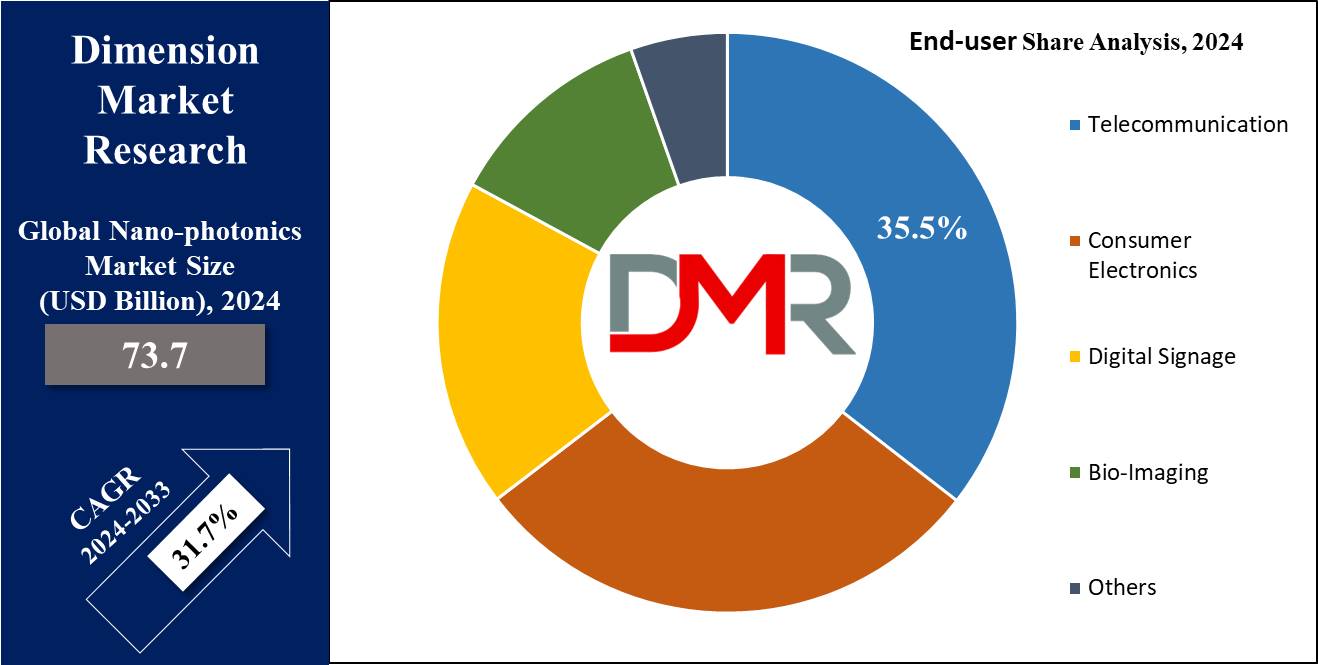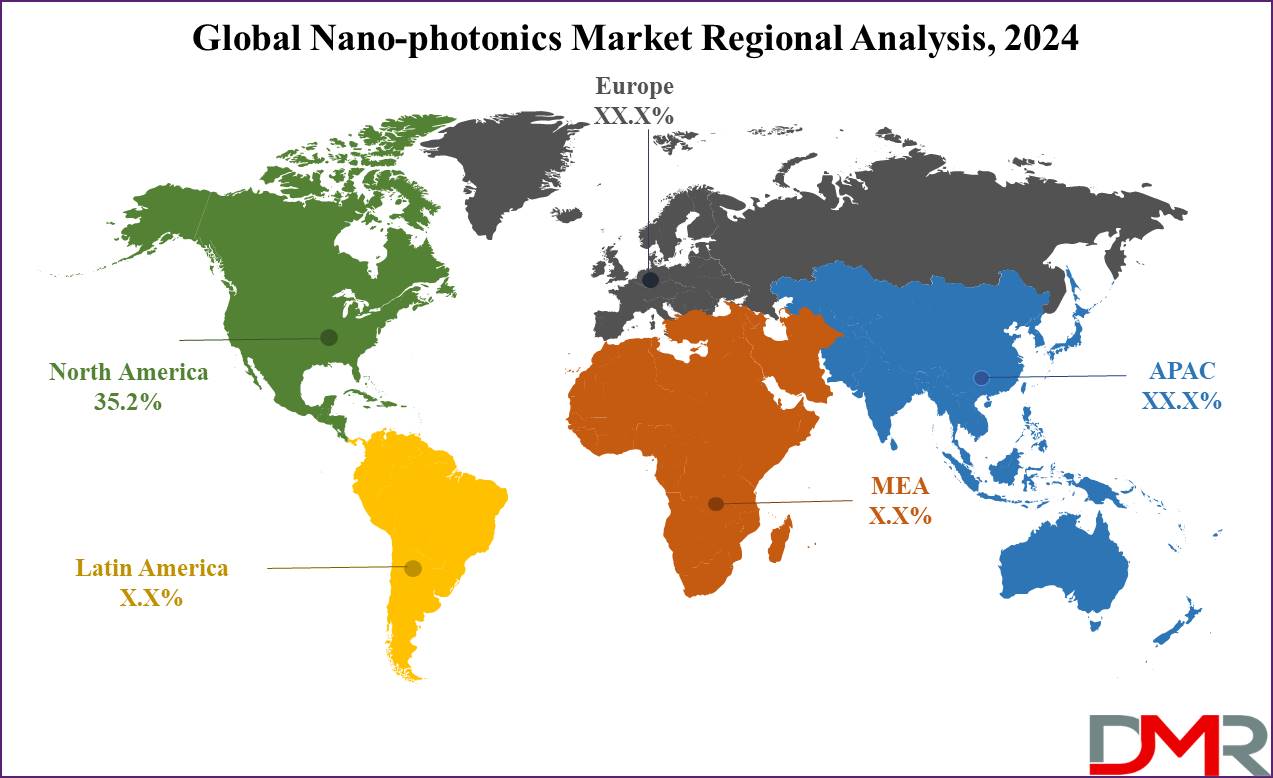Market Overview
The Global
Nano-photonics Market reached a
value of USD 55.5 billion in 2023, and it is further anticipated to reach a market value of
USD 877.1 billion by 2033 at a CAGR of 31.7%. The market has seen a significant increase in the recent past and is predicted to grow significantly during the forecasted period as well.
Nano-photonics is an inspection of light's interaction with nanoscopic structures, providing exclusive optical attributes absent in larger materials. This discovery carries potential across various sectors, allowing efficient energy conversion, fast communication, and advanced electronics. Accepting nano-photonics gives businesses a strategic advantage, promoting innovation in healthcare, telecommunications, and electronics.
By leading in this transformative technology, companies secure growth and relevance in a rapidly evolving market landscape. As industries increasingly rely on advanced solutions, those at the head of nano-photonics are poised to reshape the business landscape, driving progress and ensuring long-term success.
The US Nano-photonics Market
The US Nano-photonics market is expected to reach USD 22.6 billion by the end of 2024 while growing at a CAGR of 29.7% during the forecast period.
In the US innovations in quantum computing, renewable energy solutions, and biomedical applications can act as an opportunity for the nano-photonics market to grow. In addition, the growing integration of nanophotonics in AI, IoT, and telecommunications. Better performance in data processing and storage, along with the miniaturization of electronic devices, is driving market evolution. Also, Investment in R&D and partnerships between tech firms and academic institutions are on the rise.
Further, developments in technology, growing demand for high-speed internet, and applications in healthcare and consumer electronics are driving the market. However, it faces restraints due to high production costs, complex manufacturing processes, and regulatory challenges. In addition, limited awareness and a skilled workforce shortage further hinder the market's growth potential.
Key Takeaways
- Market Growth: The Nano-photonics Market size is expected to grow by 782.5 billion, at a CAGR of 31.7% during the forecasted period of 2025 to 2033.
- By Product Type: LED’s segment is expected to lead in 2024 with a major & is anticipated to dominate throughout the forecasted period.
- By Material: The photonic crystal material segment is expected to lead the Nano-photonics market in 2024.
- By End-users: The Telecommunications sector is expected to get the largest revenue share in 2024 in the Nano-photonics market.
- Regional Insight: North America is expected to hold a 35.2% share of revenue in the Global Nano-photonics Market in 2024.
- Use Cases: Some of the use cases of Nano-photonics include telecommunications, healthcare, and more.
Use Cases
- Telecommunications: Better data transmission speeds and bandwidth through advanced fiber optics.
- Healthcare: Enhanced imaging techniques and targeted drug delivery using nano-photonic sensors.
- Quantum Computing: Development of ultra-fast, effective computing systems using nano-photonic circuits.
- Consumer Electronics: Miniaturization and performance development of devices like smartphones and wearable technology.
Market Dynamic
Driving Factors
Technological AdvancementsRapid innovations in nanophotonics, like the development of advanced photonic integrated circuits and nanophotonic materials, are driving market growth. These technologies allow quick data processing, energy-efficient solutions, and new applications across different industries like telecommunications, computing, and healthcare.
Increasing Demand for High-Speed Internet
The growth in demand for high-speed internet and efficient data communication is driving the nanophotonic market. With the proliferation of IoT devices, smart technologies, and the increase in dependency on cloud services, nanophotonics plays a vital role in improving the performance and capacity of data transmission networks.
Restraints
High Production Costs
The manufacturing of nanophotonic components includes specialized technology and materials, leading to significant production costs, which can be a barrier to broad adoption, mainly for smaller companies and startups that may lack the financial resources to invest in these advanced technologies.
Complex Manufacturing Processes
The complex and precise processes required to produce nanophotonic devices can cause challenges in scalability and consistency. These complexities expand the potential for defects and minimize the yield rates, posing significant hurdles in meeting market demand and maintaining cost efficiency.
Opportunities
Quantum Computing Innovations
Nanophotonics provides the potential for groundbreaking developments in quantum computing, allowing faster and more efficient processing capabilities. The unique properties of nanophotonic materials can help overcome current limitations in quantum computing, providing significant opportunities for research and commercial applications.
Renewable Energy SolutionsNanophotonics can improve the efficiency of solar cells and other renewable energy technologies. By enhancing the light absorption and energy conversion rates, nanophotonic materials contribute to more effective and sustainable energy solutions, driving growth in the green technology sector and supporting global sustainability goals.
Trends
Integration with AI and IoTNanophotonics is highly integrated into
artificial intelligence (AI) and Internet of Things (IoT) devices, improving their performance and efficiency, which is driving development in smart technologies, allowing faster data processing, lower power consumption, and better device miniaturization, which are crucial for the future of connected devices and smart systems.
Advances in Photonic Integrated Circuits (PICs)
There is an increase in the trend towards the development and deployment of photonic integrated circuits, which integrate multiple photonic functions on a single chip. PICs provide major improvements in speed, energy efficiency, and integration capabilities in comparison to traditional electronic circuits, making them highly popular in telecommunications, data centers, and high-performance computing applications.
Research Scope and Analysis
By Product Type
LEDs are anticipated to stand as a major product driver in the nano-photonics market in 2024, using nanoscale engineering for detailed light emission control and sparking innovation across various sectors. Known for energy efficiency and adaptability, powering advanced displays and premium lighting solutions, LEDs maintain growth momentum. Anticipated growth in demand for high-performance LEDs further solidifies nano-photonics vital role in shaping the global technological landscape.
By Material
Photonic crystal material occupies a critical role in driving the global nano-photonics market and is expected to capture a significant amount of market share of the global market in 2023, which helps in reshaping light control through precision nanoscale engineering and catalyzing innovation across sectors. Acknowledged for customizing optical properties, from advanced communication systems to high-efficiency sensors, photonic crystals sustain strong growth. The anticipated increase in demand for customized optical solutions highlights the major influence of photonic crystal materials in shaping the resurgent global technological landscape and driving the nano-photonic market as well.
By End User
Telecommunications is set to serve as a major sector driving the technological progress for the nano-photonic market around the world by contributing significantly towards the global revenue of the market in 2024, which is further expected to grow over the forecasted period, by having innovation and connectivity solutions across diverse sectors.

Acknowledged for its strong network infrastructure and cutting-edge communication technologies, the telecommunications sector shows substantial influence. Further, the anticipated growth in demand for seamless and efficient connectivity enhances the critical role of the telecommunications end-user industry in shaping the dynamic global technological landscape.
The Nano-photonics Market Report is segmented on the basis of the following
By Product Type
- LED
- OLED
- NFO
- Photovoltaic Cells
- Optical Amplifiers
- Optical Switch
- Others
By Material
- Photonic Crystals
- Nano-ribbons
- Plasmonic Nanotubes
- Quantum Dots
- Others
By End User
- Consumer Electronics
- Telecommunication
- Digital Signage
- Bio-Imaging
- Others
Regional Analysis
The North American nano-photonics market is expected to show strong
growth by contributing 35.2% of the total market revenue of the overall global market in 2024.

Further, driven by major research & development investments, and notable technological advancements, and the presence of industry leaders like IBM, LG, and Samsung drives innovation and competition. Majorly in sectors such as healthcare and telecommunications, nano-photonics finds applications in advanced diagnostics & communication systems. Collaborative efforts between academia & industry, demonstrated by institutions like MIT and Caltech, further drive market momentum. As North America retains its technological leadership, the nano-photonics market continues to thrive, offering diverse opportunities across various sectors.
Europe
- Germany
- The U.K.
- France
- Italy
- Russia
- Spain
- Benelux
- Nordic
- Rest of Europe
Asia-Pacific
- China
- Japan
- South Korea
- India
- ANZ
- ASEAN
- Rest of Asia-Pacific
Latin America
- Brazil
- Mexico
- Argentina
- Colombia
- Rest of Latin America
Middle East & Africa
- Saudi Arabia
- UAE
- South Africa
- Israel
- Egypt
- Rest of MEA
Competitive Landscape
In the nano-photonics market's competitive landscape, major players like IBM, LG, and Samsung Electro-Mechanics drive innovation through substantial R&D investments. Collaborative efforts & a concentrated focus on application-specific solutions characterize this dynamic space as companies compete for prominence in a rapidly evolving field.
Some of the prominent players in the Global Nano-photonics Market are
- IBM
- Samsung SDI
- Viavi Solutions
- LG Display
- Lumentum Holdings
- Cnano Technology
- Wolfspeed
- Nanocs
- BuckyUSA Carbon Solutions
- Other Key Players
Recent Developments
- In December 2023, NANOBIOTIX announced the USD 4.8 million subscription by Johnson & Johnson Innovation, part of a USD 25 million investment. Further, the French Ministry of Economy approval was secured, adhering to foreign investment control rules.
- In November 2023, Photonic Inc. collaborated with Microsoft to develop a quantum networking roadmap, providing Azure access to its silicon-based quantum technology. Further, the startup secures USD 100 million in investment from Microsoft and other investors.
- In October 2023, PASQAL collaborated with Sorbonne Université, Pixel Photonics GmbH, ICFO, & IOTA to create a photonic quantum computer with neutral atom technology, funded by the European Innovation Council's Pathfinder-2023 grant.
- In October 2022, Quantum Computing Inc. announced plans for a quantum nano-photonics technology center, improving chip development capabilities & showcasing a commitment to growth and innovation in the field.
Report Details
| Report Characteristics |
| Market Size (2024) |
USD 73.7 Bn |
| Forecast Value (2033) |
USD 877.1 Bn |
| CAGR (2024-2033) |
31.7% |
| Historical Data |
2018 – 2023 |
| The US Market Size (2024) |
USD 22.6 Bn |
| Forecast Data |
2024 – 2033 |
| Base Year |
2023 |
| Estimate Year |
2024 |
| Report Coverage |
Market Revenue Estimation, Market Dynamics, Competitive Landscape, Growth Factors and etc. |
| Segments Covered |
By Product (LED, OLED, NFO, Photovoltaic Cells, Optical Amplifiers, Optica Switch and Others), By Material (Photonic Crystals, nano-ribbons, plasmonic nanoubes, Quantum Dots and Others), By End Users (Consumer Electronics, Telecommunication, Digital Signage, Bio-Imaging and Others) |
| Regional Coverage |
North America – The US and Canada; Europe – Germany, The UK, France, Russia, Spain, Italy, Benelux, Nordic, & Rest of Europe; Asia- Pacific– China, Japan, South Korea, India, ANZ, ASEAN, Rest of APAC; Latin America – Brazil, Mexico, Argentina, Colombia, Rest of Latin America; Middle East & Africa – Saudi Arabia, UAE, South Africa, Turkey, Egypt, Israel, & Rest of MEA
|
| Prominent Players |
IBM, Samsung SDI, Viavi Solutions, LG Display, Lumentum Holdings, Cnano Technology, Wolfspeed, Nanocs, BuckyUSA Carbon Solutions, and Other Key Players |
| Purchase Options |
HVMN Inc., Thync Global Inc., Apple Inc., Fitbit Inc., TrackmyStack, OsteoStrong, The ODIN, Thriveport LLC, Muse, Moodmetric, and Other Key Players |
Frequently Asked Questions
The Global Nano-photonics Market reached USD 55.5 billion in 2023, which is further expected to reach USD 877.1 billion by 2033.
North America is expected to dominate the Global Nano-photonics Market with a share of 35.2% in 2024.
The Nano-photonics Market in the US is expected to reach USD 22.6 billion in 2024.
Some of the major key players in the Global Nano-photonics Market are IBM, LG Display, Samsung SDI, and many others.
The market is growing at a CAGR of 31.7 percent over the forecasted period.